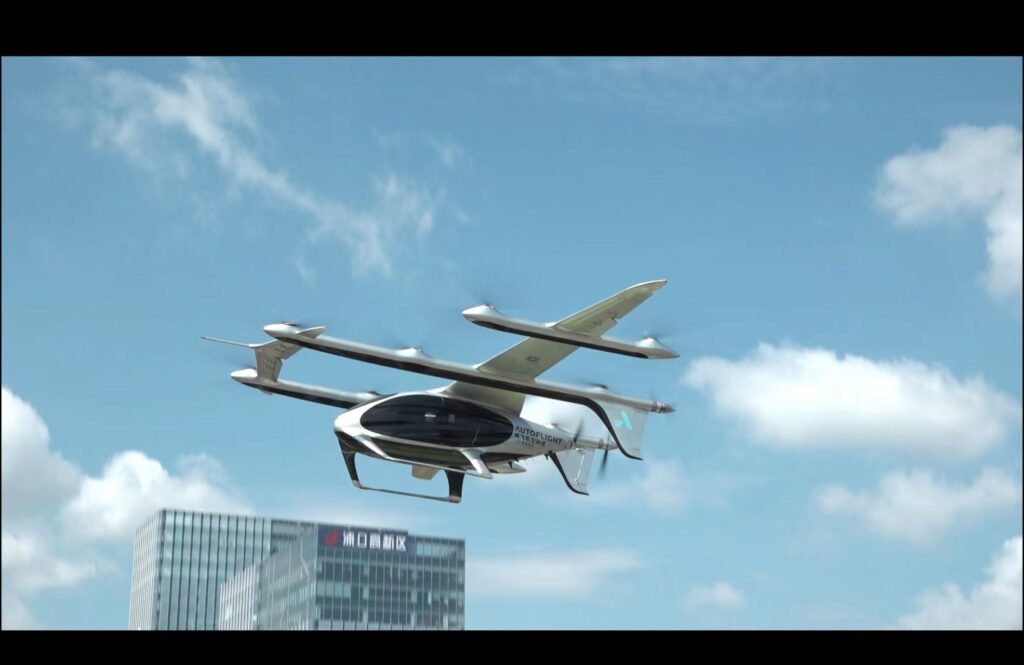This article is included in these additional categories:
On August 1, AutoFlight’s 2-ton electric vertical take-off and landing (eVTOL) aircraft completed its first cross-Yangtze River flight. The journey began at the Nanjing unmanned aerial vehicle (UAV) base in Pukou District. The aircraft took off, crossed the Yangtze River, flew along its course, and safely returned to the base. The flight, covering 25 kilometers in 10 minutes, marked the first successful cross-Yangtze journey by an eVTOL over one ton. This event emphasized the potential for low-altitude travel and cultural tourism in Nanjing.
Transforming Travel in Nanjing
Nanjing, a key transportation hub on the Yangtze River, is one of China’s foremost economic centers. Despite numerous bridges, the river remains a barrier, impacting travel. For example, the 5.5-kilometer distance between Nanjing UAV Base and Yuzui Wetland Park requires a 20-kilometer drive taking 25 minutes. An eVTOL can cover this in just 5 minutes, cutting travel time by 80%.
Nanjing, known for its historical significance as the ancient capital of the Six Dynasties, offers stunning scenic spots but struggles with traffic congestion. During holidays, travel times can increase tenfold around popular attractions. The introduction of eVTOL aircraft aims to reduce road congestion and provide tourists with unique aerial views, enhancing convenience and the sightseeing experience.
Overcoming Geographic Barriers
With 29 central cities along the Yangtze River, many areas are difficult to access. eVTOL cross-river flights provide an efficient travel solution, transforming the Yangtze from a natural barrier into a thoroughfare. AutoFlight’s Prosperity aircraft, with a pure electric propulsion system, has a maximum take-off weight of 2,200 kilograms and a five-seat cabin. Its ‘lift and cruise’ wing configuration allows for vertical take-off and fixed-wing flight for horizontal cruising. This versatility, combined with its efficiency and environmental safety, makes the Prosperity ideal for air-taxi services. The eVTOL aims to facilitate point-to-point air travel within cities and between intercity areas, with prices comparable to ground-based car services.
Strategic Partnership with CATL
Following this flight, AutoFlight and Contemporary Amperex Technology Co., Limited (CATL) announced an exclusive strategic investment and cooperation agreement worth hundreds of millions of dollars. This partnership combines leaders in eVTOL and battery technology, marking a significant sector advancement.
CATL’s investment highlights AutoFlight’s core competitiveness and long-term potential in eVTOL. As a global leader in battery technology, CATL brings extensive R&D expertise, a robust industrial foundation, and wide-ranging industrial chain advantages to the partnership.
AutoFlight and CATL will collaborate on developing eVTOL aviation batteries, focusing on enhancing energy density and performance. The aim is to support longer flights and higher load capacities while improving safety and stability. This collaboration will accelerate eVTOL battery technology development, enhancing the overall technical capabilities of eVTOL aircraft.
Commitment to Innovation and Safety
With this financing, AutoFlight is committed to advancing eVTOL technology. The company will focus on enhancing the safety and reliability of air logistics and travel solutions. Efforts will be directed toward the R&D and airworthiness certification of the Prosperity passenger aircraft. Additionally, AutoFlight will work with new energy sector leaders to advance the commercialization and market expansion of eVTOL technology, creating a comprehensive and intelligent air travel solution.
Original Story at www.environmentenergyleader.com
